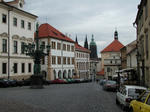Prague can be divided into following parts:
Old Town
New Town
Little Quarter (Lesser Town)
Hradcany
Europe had many fortified towns in the 13
th century. Prague, with its status of an important trading centre, had an increasing population and therefore Emperor
Charles IV. decided to found a new town with its own right and privileges. The founding charter was dated from the 8
th of March 1348. It is the first town in central Europe built according

to a concrete project. In 1347 the town was planned south-east from the fortifications of Prague. According to the plan the
New Town of Prague extends around the east and south sides of the
Old Town.
The streets were surveyed, fortifications and gates built and lands sold. The last stage was the construction of houses. New inhabitants were for 12 years freed from taxes, which made the town attractive for new settlers. And so - if we follow reports the Old Town records - "the stinky and noisy craftsmen moved to this New Town". At least 2000 people worked on this project for many years and Emperor Charles IV. co-worked with the architects. The construction work was finished in 1367. There were three big market places: The
Cattle Market, today's
Karlovo namesti (Charles Square), the
Horse Market, today's
Wenceslas Square and the
Hay Market, today's
Senovazne namesti (Haywain Square).

Today you can still see the symbol of autonomy of this town -
The New Town Hall. The square was supposed to be the main square of the town. It is more than that. Its 80 000 metres
2 make it
the biggest square in Europe.
After
the unification of Prague in 1784 the centre shifted to Wenceslas and the Old Town' s squares. Karlovo namesti was in the 19
th century turned into a park.
The New Town was, except for few churches, monasteries and palaces, torn down at the end of the 19
th century. The original urban plan remained because the streets were already broad enough in the 14
th century. One of the streets is, in fact, used as the main highway ever today. Wenceslas Square underwent fast development at the beginning of this century when the National Museum - MUSEUM REGNI BOHEMIAE was built in its upper part.
The Little Quarter (Lesser Town) was established already in 1257, built on the slopes below Prague Castle. In 1541 it was badly damaged by a great fire and than erected again during 17th and 18th century.
Hradcany was founded in 1321, during the reign of John of Luxemburg, with the purpose of housing all the employees of the Castle nearby. The gothic part of this district disappeared during the 1400's and overall because of the devastating fire of 1541. Hradcany depended directly on the Castle until 1598 when Rudolf II. allowed the founding of a town hall. From that year, the district was an independent town and it became part of the city of Prague in 1774.



 Průvodce
Průvodce 





